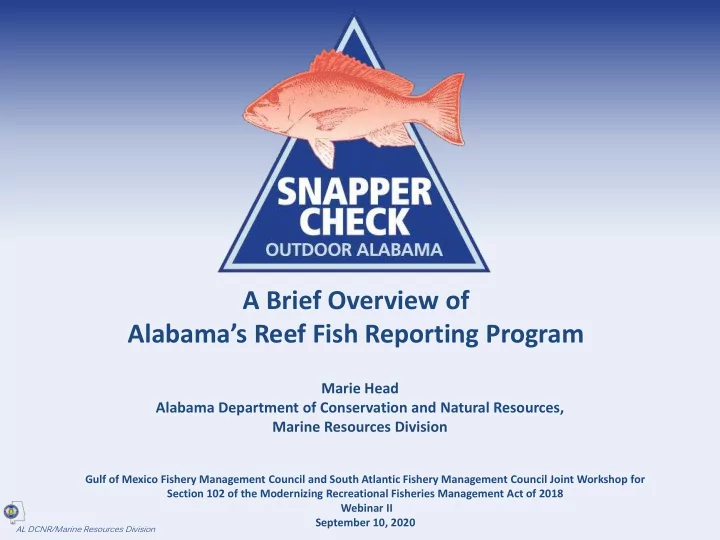

A Brief Overview of Alabama’s Reef Fish Reporting Program Marie Head Alabama Department of Conservation and Natural Resources, Marine Resources Division Gulf of Mexico Fishery Management Council and South Atlantic Fishery Management Council Joint Workshop for Section 102 of the Modernizing Recreational Fisheries Management Act of 2018 Webinar II September 10, 2020 AL DCNR/Marine Resources Division
Background Alabama’s Gulf of Mexico coastline stretches for 53 miles provides various access points for anglers to recreationally fish. Alabama and local anglers have invested in a ~1,000 mi 2 artificial reef complex since the mid- 1980’s where over 10,000 artificial reefs are estimated to exist today. Red Snapper is the most popular reef fish species for anglers to target off Alabama’s Gulf Coast. NOAA Fisheries manages the Exclusive Economic Zone (EEZ)in Federal Waters (9 miles – 200 miles) where the majority of red snapper are found. States establish size and bag limits within state waters (3 miles, up to 9 miles for Red Snapper). AL DCNR/Marine Resources Division
Background NOAA Fisheries stock assessments provide reference points on the status of the population which are used to establish maximum harvest levels. Fisheries managers and scientists use catch information gathered from federal recreational fisheries surveys (MRIP and MRFSS) to aid in state management of inshore species. Federal estimates of Alabama recreational Red Snapper landings throughout the 1990’s and 2000’s ranged between 30 -35% of Gulf recreational landings. In 2006, reauthorization of the Magnuson-Steven Fishery Management and Conservation Act resulted in significant changes which increased harvest restrictions. AL DCNR/Marine Resources Division
Background In 2013, the federal Red Snapper season was reduced to 28 days. The Commissioner of ADCNR promulgated a regulation in 2014, prior to the recreational season, which required reporting of red snapper landed in Alabama by recreational vessels. Recreational vessel owners/operators (federal for-hire, headboat, state for-hire and private vessels) are responsible for submitting landing reports prior to landing their Red Snapper harvest in Alabama. Ways to report landings: online , smartphone app (android or apple), carbonless paper ticket, (Toll-free number used through 2016). Landing report information reported includes: • Date and time (for paper report only) • Vessel registration or Conservation ID • # of anglers • # of fish harvested • # of released dead • county of landing • trip type (private or charter) • access type for private vessels and trip length for charter vessels. AL DCNR/Marine Resources Division
Data Collection Photo Credit: MRD Staff Snapper Check utilizes the capture-recapture survey method for estimating rates of non- reporting. Dockside surveys (capture) and landing reports (recapture) gather the same information so that comparisons (match trips) can be made to help estimate the number of non-reporting vessels. Dockside sampling sites are selected using random, stratified probability proportional to size sampling methodology, using MRIP APAIS site frame. Dockside data is QA/ QC’d after entry. Vessel registrations from both data sets are compared to a master list of charter vessels to validate that trip type is recorded correctly. AL DCNR/Marine Resources Division
Estimate Calculations Snapper Check is currently certified by NOAA Fisheries as a scientifically valid survey method, but data has not been used in federal stock assessments. Landings estimation: Landing Dockside Reports Surveys Sum of Adjustment Average Estimated All Factor for Trip Non- Weight Harvest Reported Reporting* Fish Non-reporting adjustment factor: 1 • Attempt is made to calculate proportion of vessels that do not report trip information. *Adjust. Factor = • Landing records and dockside survey records are ) ( No. Fish from Matched compared to one another. Dockside Surveys & Landing Reports • A “match” is made if the date, vessel reg. number, No. Fish from All Dockside number of fish and anglers, and time of interview Surveys (w/in 3.5 hours of survey time) match. AL DCNR/Marine Resources Division
Recent Developments within Snapper Check Alabama anglers will have recreational mandatory reporting of two additional reef fish species; Gray Triggerfish and Greater Amberjack beginning in 2021. Kayak and shore anglers will now have an option to report their catch by selecting the “unpowered vessel/shore” option, available on the app and online. Improved the connectivity when reporting through the app. Streamlined reporting options down to online reporting or via smartphone app. AL DCNR/Marine Resources Division
Thank You AL DCNR/Marine Resources Division
Recommend
More recommend